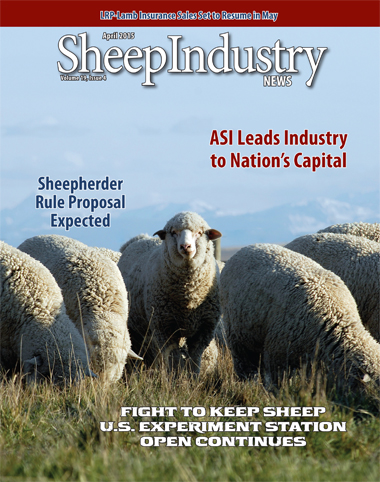
- April 2015
- President’s Notes
- ASI Takes Sheep Issues to D.C.
- ‘Let’s Grow’ Points to South Dakota Success
- Fight to Keep Sheep Station Open Continues
- Workshop Provides Insight to Fall Lambing
- ASI Joins Request to Fund Animal Sciences
- LRP-Lamb Expected to Be Made Available in May
- Market Report
- Nominations for Lamb Board Due May 1
- Sheepherder rule proposals are expected
- U.S. Forest Service Risk Assessment Study Could Borrow From Wyoming’s Sheep Plan
- News Briefs
- Classifieds April 2015
U.S. Forest Service Risk Assessment Study Could Borrow From Wyoming’s Sheep Plan
In a move watched closely by sheep producers in other states, the Wyoming legislature passed a pair of historic bills that will effectively keep domestic sheep and bighorn sheep separated.
It’s the latest action involving a historic way of life.
“My family history is that John Sims, Sr.,” rancher Shaun Sims said, “which is six generations back from me, come to the Evanston area in 1865 and settled there.”
But it hasn’t been easy for the Sims family. Ever since the 1970s, sheep ranching has become almost as endangered as bighorn sheep. New environmental rules barred lethal control of predators and Americans lost their taste for mutton. And that dropped the numbers of sheep from six million at its peak to current numbers of around 300,000. And with so few neighbors raising sheep, ranching is more complicated.
“Slaughter plants for our lambs, the sheering to get the sheep sheered, the trucking industry, the whole infrastructure is shrunk as the sheep industry has shrunk,” explained Sims. Sims pointed south at the peaks of the Uinta Range, dusted in spring snow. It’s here that he moves his herds to fatten his lambs in the summer.
The Uintas, however, are in Utah, not Wyoming. He points out a craggy peak.
“The bighorn sheep are east of that. And they range all the way down to Flaming Gorge.”
It’s a herd transplanted there in the 1980s and it’s migrating close to Sims’ grazing allotments. The problem is Utah doesn’t allow sheep to mingle with bighorns because of the threat of spreading pneumonia and wiping out the herd. When sheep graze too close, young bighorn rams often go looking for love in all the wrong places and can wander the countryside for miles, spreading the bacteria. But in Wyoming, transplanted herds like this one are allowed to mingle with sheep.
Wild Sheep Foundation director Kevin Hurley said it’s protecting native herds at any cost that’s the basic idea behind Wyoming’s sheep plan.
“In Wyoming, we currently enjoy between six and seven thousand bighorn sheep. The majority of those, 90 percent of those, are in our core native herds in the northwest quadrant of Wyoming,” Hurley said.
For years, the U.S. Forest Service has said if every state would do what Wyoming has done, sheep ranchers and wildlife advocates could resolve their disputes. But Hurley says other states might not have the stamina Wyoming did to reach consensus on some very basic points, like the science behind whether sheep really spread pneumonia to bighorns.
“The science is not absolute,” Sims pointed out. “There’s other stress factors that cause the disease to pronounce itself.”
Hurley disagrees. “The science is real. We’ve asked for a single peer-reviewed published piece of scientific literature that says they’re compatible and they can be fine together. We’re not aware of one.”
Chris Iverson, Deputy Regional Forester for the U.S. Forest Service’s Intermountain Region, said two of Wyoming’s core native bighorn sheep herds – the Jackson and the Whiskey Mountain herds – are really struggling.
In an effort to help bighorn sheep thrive, the U.S. Forest Service is working on a risk assessment study of the Western U.S. that could borrow heavily from Wyoming’s sheep plan. It would protect native herds at any cost and de-emphasize transplanted ones. In fact, last month, Iverson’s office sent a letter to Governor Mead confirming the U.S. Forest Service support. But asked whether it would it work for every state, he says, “each state has to do what’s best for their state under their specific circumstances.”The Forest Service plans to complete its bighorn/domestic sheep risk assessment in coming months.

